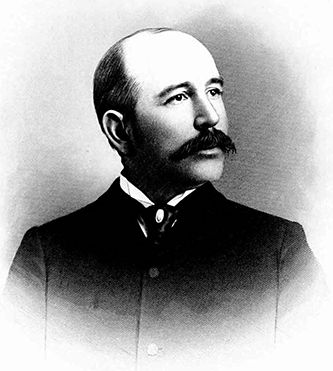Morgan, Samuel Tate
15 May 1857–16 Apr. 1920
 Samuel Tate Morgan, manufacturer of chemical fertilizer, was born in the Fishdam district of Wake County (now a part of Durham County), the son of Samuel Davidson and Talithia Adaline Tate Morgan. Samuel, a farmer, died in 1865. Morgan's early life was spent in comfort on his father's farm. He was educated at Bingham Military School and at nearby Horner Military School. Leaving school in 1874, he began to assist his widowed mother on her plantation. Five years later he moved to the village of Durham, where Julian S. Carr, William T. Blackwell, and the Dukes were gaining national attention with Bull Durham smoking tobacco and Duke's Mixture. There is some evidence that Morgan knew the Duke family from his early years. At first he entered the grain and provision business and also handled chemical fertilizers.
Samuel Tate Morgan, manufacturer of chemical fertilizer, was born in the Fishdam district of Wake County (now a part of Durham County), the son of Samuel Davidson and Talithia Adaline Tate Morgan. Samuel, a farmer, died in 1865. Morgan's early life was spent in comfort on his father's farm. He was educated at Bingham Military School and at nearby Horner Military School. Leaving school in 1874, he began to assist his widowed mother on her plantation. Five years later he moved to the village of Durham, where Julian S. Carr, William T. Blackwell, and the Dukes were gaining national attention with Bull Durham smoking tobacco and Duke's Mixture. There is some evidence that Morgan knew the Duke family from his early years. At first he entered the grain and provision business and also handled chemical fertilizers.
He began his lifework in 1881 with the organization of the Durham Fertilizer Company, which grew into the Virginia-Carolina Chemical Company, chartered in New Jersey on 12 Sept. 1895. The original authorized stock was for $6,500,000. By 1916 the outstanding common stock stood at $27,984,400 and the preferred at $20,000,000. Also by 1916 its output was the largest of any fertilizer company in the world, and the corporation controlled 135 affiliated plants scattered generally over the southeastern United States. Morgan was able to expand the Virginia-Carolina Chemical Company by means of aid from the Dukes. In 1897 Benjamin N. Duke sought assistance for Morgan through Senator Jeter C. Pritchard to reduce the duty on burlap as proposed in the Dingley Tariff Bill. Shortly afterwards, Duke purchased 3,050 shares in Morgan's company. In addition, early in January 1900 Duke supplied approximately $100,000 to increase the capital of VCC, as the company was generally known. Later in the year, however, he decided not to aid Morgan in the purchase of sulfur mines because of his involvement in many other projects, although he believed Morgan's plan to be "a good thing" for the company. Morgan wrote Duke in 1898 that he was going to buy up some plants in South Carolina and Georgia "which with what we have would give us control of the Fertilizer business in the South and enable the Co. to make enormous profits." Morgan laid the matter before James B. Duke and his associates. No available record shows Duke's reaction, but when Morgan died, James B. Duke and several high officials of the American Tobacco Company served as honorary pallbearers. The great profit from stock in the VCC ended with the agricultural depression of the early 1920s and the death of Morgan—almost simultaneous events.
Moving the headquarters of his company to Richmond, Va., in 1896, Morgan soon became immersed in various businesses in that state such as the Merchants National Bank, the Virginia Trust Company, and the Old Dominion Trust Company. His wealth placed him on many other directorates, including those of the Texas and Pacific Railroad, Southern Cotton Oil Company, Mechanics and Metals National Bank of New York, and Charleston Mining and Manufacturing Company. He enjoyed membership in such clubs as the Westmoreland, the Commonwealth Club, the Deep Run Hunt Club, and three groups in New York: the Calumet, the Manhattan, and the New York Yacht Club. Morgan lived in Richmond but maintained an elaborate country place, Meadowbrook, near Curle's Neck, Va.
On 5 Sept. 1875 he married Sally F. Thompson, the daughter of George W. Thompson of Wake County. They had three children: Alice Blanche, Maude Crenshaw, and Samuel Tate, Jr. Morgan, a member of the Baptist church, was a Democrat in name. He was buried in Hollywood Cemetery, Richmond.
References:
Samuel A. Ashe, ed., Biographical History of North Carolina, vol. 5 (1906).
Paul B. Barringer, The Natural Bent (1949).
Benjamin Newton Duke Papers (Manuscript Department, Duke University, Durham).
Report of Federal Trade Commission on the Fertilizer Industry (19 Aug. 1916).
Richmond Times-Dispatch, 17–18 Apr. 1920.
Additional Resources:
"Samuel Tate Morgan." History Beneath Our Feet. Museum of Durham History. http://museumofdurhamhistory.org/beneathourfeet/people/MorganTSamuel (accessed April 5, 2013).
Leornard, John William, editor. "Morgan, Samuel Tate." Who's who in Finance, Banking, and Insurance, Volume 1. New York: Joseph & Sefton, Publishers. 1911. 955-956. http://books.google.com/books?id=ZaooAAAAYAAJ&lpg=PA956&ots=90g3mpyzxM&pg=PA955#v=onepage&q&f=false (accessed April 5, 2013).
Kueber, Gary. "Durham / Virginia-Carolina Chemical / Fertilizer Company." OpenDurham.org. 2009. http://www.opendurham.org/buildings/durham-virginia-carolina-chemical-fertilizer-company (accessed April 8, 2013).
Documents Relating to the Fertilizer Industry 1866-1966, Virginia Carolina-Chemical Company and subsidiaries (call #:MS105). University of North Carolina at Wilmington Archives and Special Collections Online Database. http://randall3.uncw.edu/ascod/?p=collections/controlcard&id=79 (accessed April 8, 2013).
"Unity Monument at Bennett Place Historical Site, Durham." Commemorative Landscapes of North Carolina. Documenting the American South, University of North Carolina at Chapel Hill. https://docsouth.unc.edu/commland/monument/44/ (accessed April 5, 2013).
Anderson, Jean Bradley. Durham County: A History of Durham County, North Carolina. Durham, N.C.: Duke University Press. 1990. 126. http://books.google.com/books?id=_d9hqndUVMMC&lpg=PA126&ots=GcZD0UpA1-&pg=PA126#v=onepage&q&f=false (accessed April 5, 2013).
Image Credits:
E.G. Williams and Bro. "S.T. Morgan." Engraving. Biographical history of North Carolina from colonial times to the present. Greensboro, N.C. : C. L. Van Noppen. 1905. 287.
1 January 1991 | Tilley, Nannie M.